During a two-week adventure through Nueva Ecija last summer, I found myself in a small town where every morning began with the rhythmic sounds of cooking from my host family's kitchen. One particularly memorable morning, I woke to an intriguing aroma that led me straight to Lola Elena's kitchen. There she stood, stirring a dark, richly-colored stew that she called Tinumis sa Sampaloc.
"This is not dinuguan," she said with a knowing smile, noticing my curious expression. As she explained the dish's heritage in Nueva Ecija and Bulacan, she shared how her grandmother taught her the precise technique of adding the pork blood while continuously stirring to achieve that perfect, silky consistency.
That morning, watching Lola Elena prepare this dish with such care and precision, I learned that Tinumis sa Sampaloc is more than just a variation of dinuguan – it's a testament to regional Filipino cooking, where subtle differences in technique and ingredients create something entirely unique. Now, every time I prepare this dish in my own kitchen, I remember Lola Elena's careful instructions and the way she taught me to respect each step of the process.
This recipe is my attempt to capture the magic of that morning in her kitchen.
Jump to:
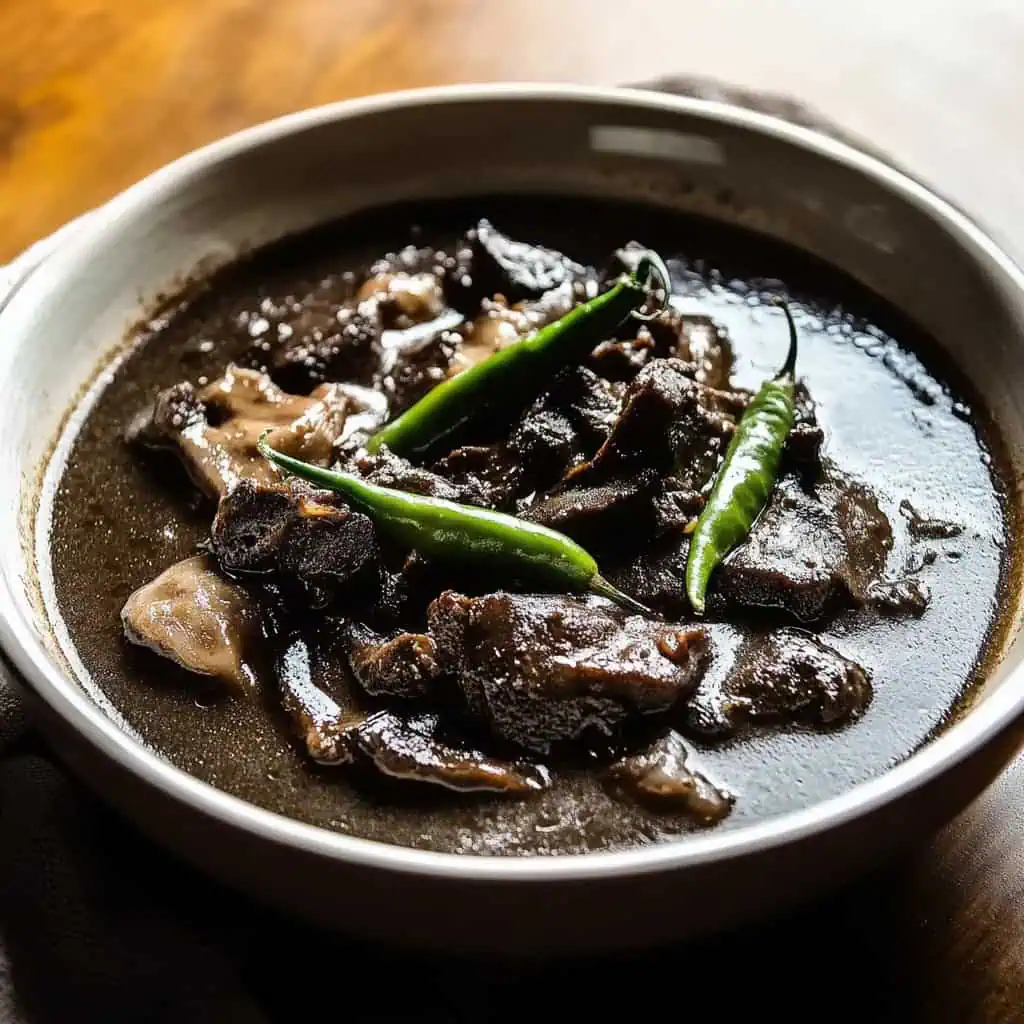
Why You'll Love This Recipe
This authentic Filipino dish represents the ingenious way our ancestors transformed every part of an animal into something delicious. The combination of tender pork, rich blood, and sour tamarind creates a complex flavor profile that's both bold and comforting. Unlike its cousin dinuguan, Tinumis sa Sampaloc has a distinctly tangy profile that cuts through the richness perfectly.
Ingredients
Each component plays a vital role in this traditional dish: pork belly provides rich flavor and tender texture; pig's blood creates the distinctive velvety sauce; tamarind delivers the signature sourness that balances the richness; aromatics (garlic, ginger, onion) build a flavorful base; green chilies add gentle heat without overwhelming the dish; and tomato contributes subtle acidity and natural sweetness that rounds out the flavor profile perfectly.
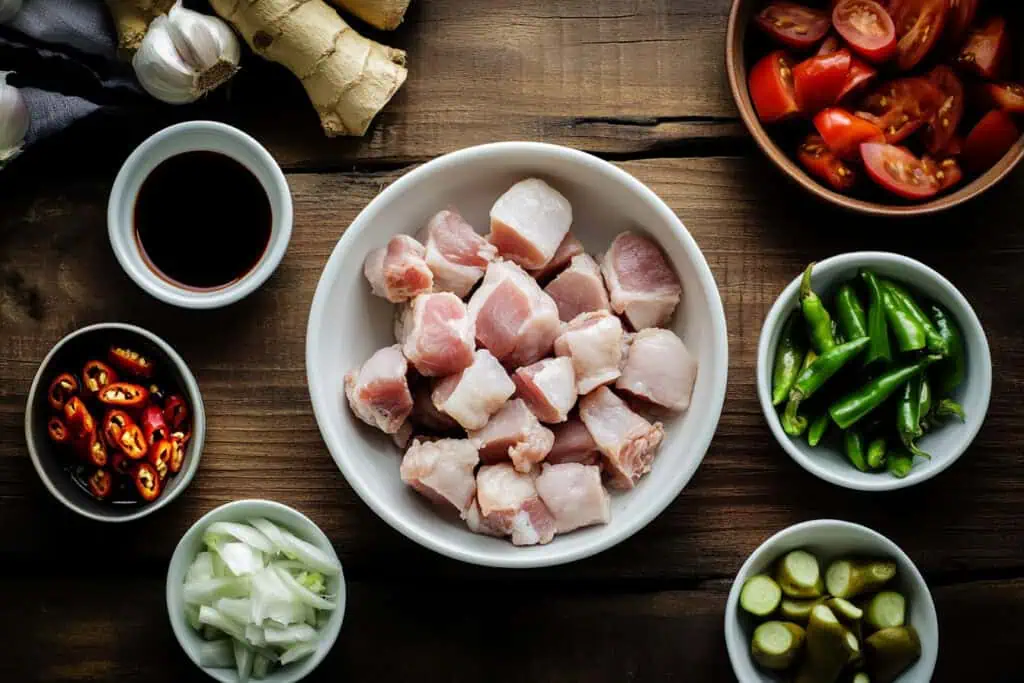
- 750 g pork belly, cut into 1-inch cubes
- 1¼ cups pigs' blood
- 3 cups water
- 6 green finger chilies
- 1 ripe tomato, chopped
- 1 whole head garlic, minced
- ½ thumb-sized ginger, minced
- 1 large onion, finely chopped
- 20 g sinigang mix or 4-5 pieces fresh tamarind
- Salt to taste
- Freshly ground black pepper to taste
Equipment
- Large heavy-bottomed pot (kaldero) - For even heat distribution and preventing burning. This is crucial when cooking with blood to prevent curdling and sticking.
- Sharp knife - For cutting meat into uniform pieces, ensuring even cooking throughout the dish.
- Wooden spoon - For stirring without scratching the pot. Metal utensils can react with the acidity in the dish and affect flavor.
- Cutting board - For safely preparing all ingredients before cooking begins.
- Measuring cups and spoons - For precise measurements, especially important when balancing the sour and savory flavors.
- Fine-mesh strainer - For straining tamarind pulp if using fresh tamarind, ensuring a smooth sauce without seeds or fibers.

How To Make
- First prepare all your ingredients. Cut the pork belly into 1-inch cubes, mince the garlic and ginger, finely chop the onions, quarter the tomatoes, and set aside the green chilies whole. If using fresh tamarind, soak pods in hot water and extract the juice.
- Heat your heavy pot over medium-high heat (190°C/375°F). Add a tablespoon of oil and brown the pork belly pieces until they develop a golden color on all sides, about 8-10 minutes. You want to hear a gentle sizzle, not an aggressive fry.
- Lower the heat to medium (175°C/350°F). Add garlic, onions, and ginger to the browned pork. Sauté everything together until the onions become soft and translucent, around 5-7 minutes. The kitchen should be filled with a fragrant aroma at this point.
- Add the whole green chilies, tomatoes, and your souring agent (either sinigang mix or tamarind extract). Pour in the water and bring everything to a boil. Once boiling, reduce heat to low (150°C/300°F) and let it simmer for 30 minutes, or until the pork becomes tender when pierced with a fork.
- Here comes the crucial step: slowly pour in the pig's blood while continuously stirring in one direction. Keep the heat low (140°C/285°F) and maintain a gentle simmer for 20 minutes. Stir occasionally to prevent the sauce from sticking to the bottom. The blood should thicken the sauce without forming any lumps.
- Season with salt and black pepper to taste. The sauce should be thick enough to coat the back of a spoon. If it's too thick, add water little by little while stirring. If too thin, simmer for a few more minutes.
- Let everything rest for 5 minutes before serving. This allows the flavors to settle and the sauce to achieve the perfect consistency. Serve hot with steamed white rice and extra chilies on the side if you like it spicier.
Remember, the key to perfect Tinumis is patience and attention to the heat - keep it low and slow once you add the blood, and you'll be rewarded with a smooth, velvety sauce every time.

Tips from Lola's Kitchen
- Fresh blood is best: Fresh pig's blood should be mixed with vinegar right after collecting to prevent coagulation. If you have a reliable source, this makes a significant difference in texture.
- Stirring technique matters: When adding the blood, stir in one consistent direction to prevent curdling. This creates the silky texture that distinguishes excellent Tinumis.
- Temperature control is crucial: The heat should be at its lowest when adding and cooking the blood. Too high heat will cause the proteins to seize and form lumps.
- Taste as you go: The balance of sour, savory, and richness is personal. Adjust seasonings gradually until you find your perfect balance.
- Don't rush the process: The slow cooking develops depth of flavor. Allow the full cooking time for the best results.
- Let it rest: Allowing the finished dish to rest for 5-10 minutes before serving lets the flavors meld and the sauce thicken to the perfect consistency.
Substitutions
- Meat options: If pork belly isn't available, use pork shoulder or a combination of offal (liver, heart, intestines) for an even more traditional approach.
- Souring agents: Fresh tamarind is traditional, but sinigang mix provides good flavor in a pinch. Kamias (bilimbi) can also be used for a different but authentic sour note.
- Chilies: Green finger chilies (siling haba) provide moderate heat. Adjust the quantity or substitute with bird's eye chilies (siling labuyo) for more heat or bell peppers for less.
- Blood options: If fresh blood isn't available, frozen blood can work—just ensure it's fully thawed and at room temperature before adding.
- For a richer flavor: Add 1-2 tablespoons of fish sauce (patis) instead of some of the salt for a deeper umami flavor.
Troubleshooting
- Curdled blood sauce: If you notice the blood starting to curdle, immediately lower the heat and whisk vigorously until smooth. Adding a splash of vinegar can sometimes help restore texture.
- Too thick sauce: Add water gradually, about 2 tablespoons at a time, while stirring constantly until you reach the desired consistency.
- Too thin sauce: Continue simmering uncovered to reduce the liquid, stirring occasionally to prevent sticking.
- Too sour: Balance with a pinch of sugar or a bit more salt to counteract extreme sourness.
- Not sour enough: Add more tamarind extract or a splash of native cane vinegar (sukang iloko) to enhance the tanginess.
- Meat too tough: If after the recommended cooking time the pork isn't tender, continue simmering for 15-minute increments until fork-tender.
Storage & Reheating
- Refrigeration: Store in an airtight container for up to 3 days. The flavors often deepen and improve overnight, making this an excellent make-ahead dish.
- Freezing: Tinumis freezes well for up to 1 month. Thaw completely in the refrigerator before reheating.
- Reheating: Always reheat slowly over low heat, stirring occasionally to prevent the bottom from scorching. The sauce may thicken when stored, so add a splash of water while reheating if needed.
- Portioning: For easier reheating, consider storing in individual portion sizes rather than one large container.
- Food safety: Always bring leftovers to a full simmer when reheating to ensure food safety, especially because of the blood component.
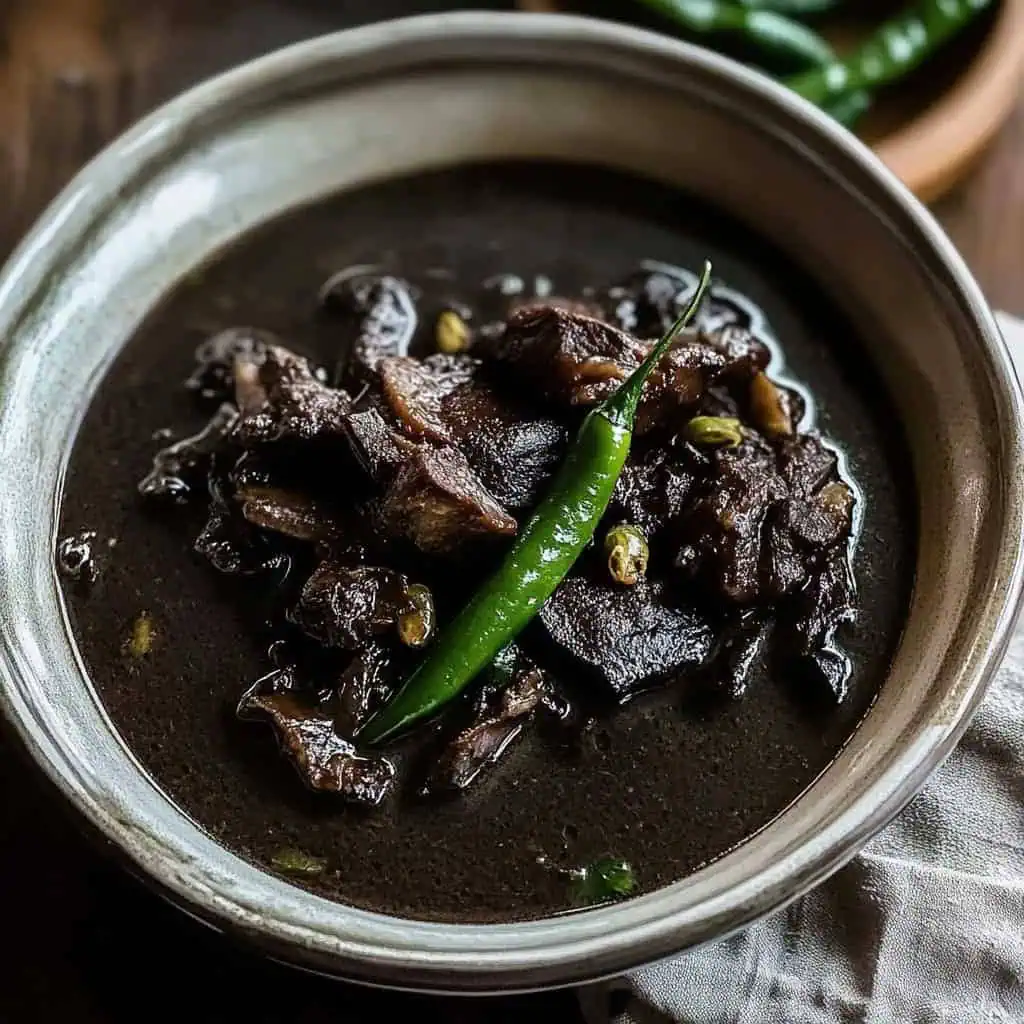
FAQ
Can I make this without pork blood?
While the blood is essential to authentic Tinumis, you can make a sour pork stew version using just the tamarind base. It won't be traditional Tinumis, but it will still be delicious.
How do I know when the pork is properly cooked?
The pork should be tender enough to easily pierce with a fork, usually after 30-35 minutes of simmering. If you're using tougher cuts or offal, it might take longer.
Can I make this in advance for a party?
Yes, it actually tastes better the next day as the flavors develop further. Make it up to two days ahead, refrigerate, and reheat gently before serving.
How spicy is this dish?
With whole green finger chilies, the heat level is moderate but customizable. For less heat, remove the chilies before serving. For more heat, slice them open or substitute with hotter varieties.
Where can I find pig's blood?
Fresh pig's blood is available at some Filipino or Asian markets, specialty butchers, or directly from pig farmers. Frozen blood is more widely available and works well, too.
Is this dish gluten-free?
Yes, traditional Tinumis is naturally gluten-free. Just be careful with commercial sinigang mixes, which might contain additives with gluten.
Can I use this recipe for a larger crowd?
Yes, the recipe doubles well. Just ensure you use a pot large enough to accommodate the increased volume and adjust cooking time slightly.
What's the difference between Tinumis and Dinuguan?
While both are Filipino blood stews, Tinumis specifically uses tamarind as its souring agent and is regional to Nueva Ecija and Bulacan. Dinuguan typically uses vinegar and may include a wider variety of pork parts.
Related
Looking for other recipes like this? Try these:
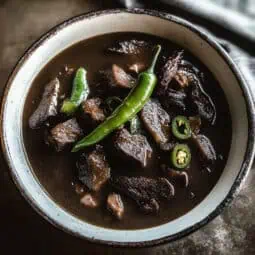
Tinumis sa Sampaloc (Filipino Pork Blood Stew with Tamarind)
Equipment
- Large heavy-bottomed pot (kaldero) For even heat distribution and preventing burning
- Sharp Knife (Matatalas na Kutsilyo) For cutting meat into uniform pieces
- Wooden spoon (sandok na kahoy) For stirring without scratching the pot
- Cutting board (Sangkalan) For preparing ingredients
- Measuring cups and spoons (Panukat) For precise measurements
- Fine-mesh strainer (salaan) For straining tamarind pulp if using fresh tamarind
Ingredients
- 750 g pork belly liempo, cut into 1-inch cubes
- 1¼ cups pigs' blood dugo ng baboy
- 3 cups water tubig
- 6 green finger chilies siling haba
- 1 ripe tomato kamatis, chopped
- 1 whole head garlic bawang, minced
- ½ thumb-sized ginger luya, minced
- 1 large onion sibuyas, finely chopped
- 20 g sinigang mix or 4-5 pieces fresh tamarind/sampaloc
- Salt asin to taste
- Freshly ground black pepper paminta to taste
Instructions
- First prepare all your ingredients. Cut the pork belly into 1-inch cubes, mince the garlic and ginger, finely chop the onions, quarter the tomatoes, and set aside the green chilies whole. If using fresh tamarind, soak pods in hot water and extract the juice.
- Heat your heavy pot over medium-high heat (190°C/375°F). Add a tablespoon of oil and brown the pork belly pieces until they develop a golden color on all sides, about 8-10 minutes. You want to hear a gentle sizzle, not an aggressive fry.
- Lower the heat to medium (175°C/350°F). Add garlic, onions, and ginger to the browned pork. Sauté everything together until the onions become soft and translucent, around 5-7 minutes. The kitchen should be filled with a fragrant aroma at this point.
- Add the whole green chilies, tomatoes, and your souring agent (either sinigang mix or tamarind extract). Pour in the water and bring everything to a boil. Once boiling, reduce heat to low (150°C/300°F) and let it simmer for 30 minutes, or until the pork becomes tender when pierced with a fork.
- Here comes the crucial step: slowly pour in the pig's blood while continuously stirring in one direction. Keep the heat low (140°C/285°F) and maintain a gentle simmer for 20 minutes. Stir occasionally to prevent the sauce from sticking to the bottom. The blood should thicken the sauce without forming any lumps.
- Season with salt and black pepper to taste. The sauce should be thick enough to coat the back of a spoon. If it's too thick, add water little by little while stirring. If too thin, simmer for a few more minutes.
- Let everything rest for 5 minutes before serving. This allows the flavors to settle and the sauce to achieve the perfect consistency. Serve hot with steamed white rice and extra chilies on the side if you like it spicier.
- Remember, the key to perfect Tinumis is patience and attention to the heat - keep it low and slow once you add the blood, and you'll be rewarded with a smooth, velvety sauce every time.
Tips from Lola's Kitchen
- Fresh pig's blood should be mixed with vinegar right after collecting to prevent coagulation
- Cut pork into uniform sizes for even cooking
- If using fresh tamarind, soak in hot water and strain before using
- Stir blood mixture constantly to achieve smooth texture
Nutrition
The Story Behind Tinumis sa Sampaloc
The story of Tinumis sa Sampaloc weaves through the rich tapestry of Filipino culinary history, particularly in the regions of Nueva Ecija and Bulacan. This distinctive blood stew represents the evolution of Filipino cooking practices, where regional variations gave birth to unique interpretations of traditional dishes. While many Filipinos are familiar with dinuguan, Tinumis emerged as a specialized preparation that showcases the ingenuity of local cooks in these provinces.
The dish's origins can be traced back to the ancient practice of sampayna, a tradition that emerged from the Philippine practice of whole-animal butchery. During the preparation of lechon, butchers would carefully collect the pig's blood, mixing it with vinegar to prevent coagulation – a technique that demonstrates our ancestors' deep understanding of food preservation and preparation methods. This practice laid the foundation for both dinuguan and its regional cousin, Tinumis.
What sets Tinumis sa Sampaloc apart is its distinctive use of tamarind (sampaloc), a souring agent that gives the dish its characteristic tang. This choice of ingredient wasn't arbitrary; it reflected the abundant availability of tamarind trees in the region and the local palate's preference for more pronounced sour notes. The incorporation of tamarind also speaks to the Filipino culinary principle of balancing rich flavors with acidity, a cornerstone of our national cuisine.
In Nueva Ecija and Bulacan, Tinumis became more than just a dish – it evolved into a symbol of regional pride and culinary expertise. Local cooks developed specific techniques for achieving the perfect consistency of the sauce, timing the addition of blood, and balancing the interplay between richness and sourness. These techniques were passed down through generations, often taught by grandmothers to their grandchildren in the intimate setting of family kitchens.
Today, Tinumis sa Sampaloc stands as a testament to the diversity of Filipino cuisine. While modernization has introduced new cooking methods and ingredients, the fundamental preparation of Tinumis remains largely unchanged, preserving a piece of our culinary heritage. This adherence to tradition reflects the deep respect Filipinos hold for their food heritage and the importance of preserving regional specialties in an increasingly globalized world.
The dish also embodies the Filipino value of resourcefulness, transforming humble ingredients into a celebrated delicacy. By utilizing parts of the pig that might otherwise go to waste, our ancestors created not just a meal, but a sustainable cooking practice that resonates with modern concerns about food waste and responsible consumption. This aspect of Tinumis makes it particularly relevant in contemporary discussions about sustainable cooking and food heritage preservation.
As Filipino cuisine gains international recognition, dishes like Tinumis sa Sampaloc serve as perfect examples of the depth and sophistication of our regional cooking traditions. Each bowl tells a story of cultural preservation, family heritage, and the continuing evolution of Filipino flavors.
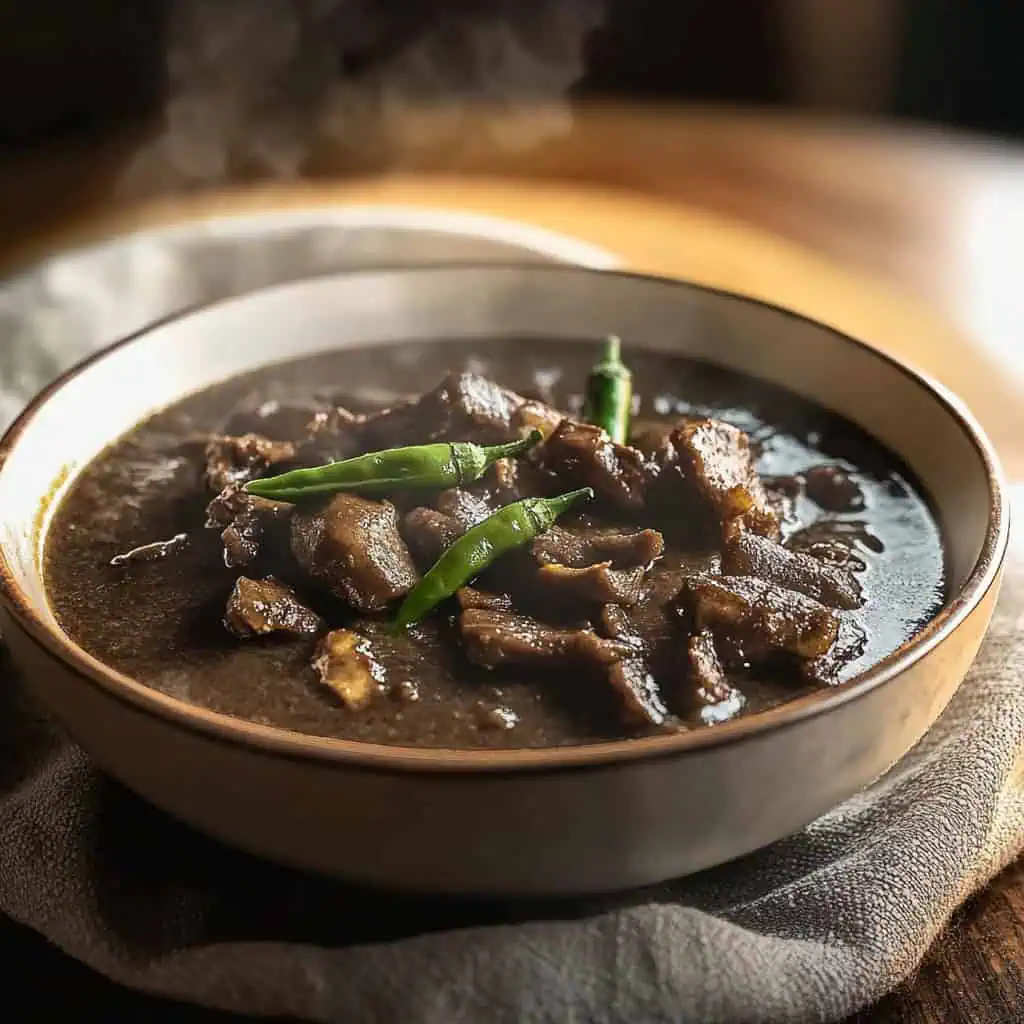









Comments
No Comments